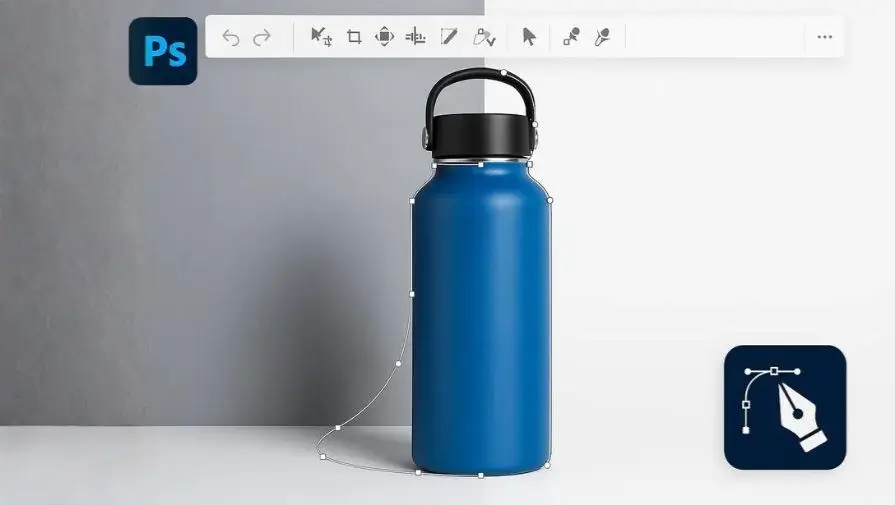A clipping path is a hand-drawn vector outline used to cut an object from its background in photo editing. It isolates the subject with clean, sharp edges using the Photoshop Pen Tool, making it ideal for product images and eCommerce visuals.
How Clipping Path Works

Now that you know what a clipping path is, here’s how the process works step by step.
- Open the image in Photoshop.
- Use the Pen Tool to draw a closed path around the object.
- Make the selection and remove the background.
- Save the image in a format that supports transparency, such as PNG or PSD.
This workflow applies to simple, medium, complex, and super complex clipping paths. For soft edges like hair or fur, image masking may be needed.
Clipping Path vs. Image Masking (Quick Comparison)
| Feature | Clipping Path | Image Masking |
| Best For | Hard-edged items | Soft-edged items |
| Technique | Pen Tool (vector) | Brush & Channel Masking |
| Edge Precision | Sharp & clean | feathered, semi-transparent |
| Use Case | eCommerce products | Complex & Transparent Images |
Use clipping path for solid edges and masking for soft, intricate, or transparent edges. A professional workflow often combines both for the best results. Learn more about the difference between clipping path and image masking in our detailed guide here.
Clipping Path Tutorial (Step-by-Step)
Step 1: Open Your Image in Photoshop

Start by importing the image you want to edit. Make sure it’s high-resolution for the best results.
Step 2: Select the Pen Tool
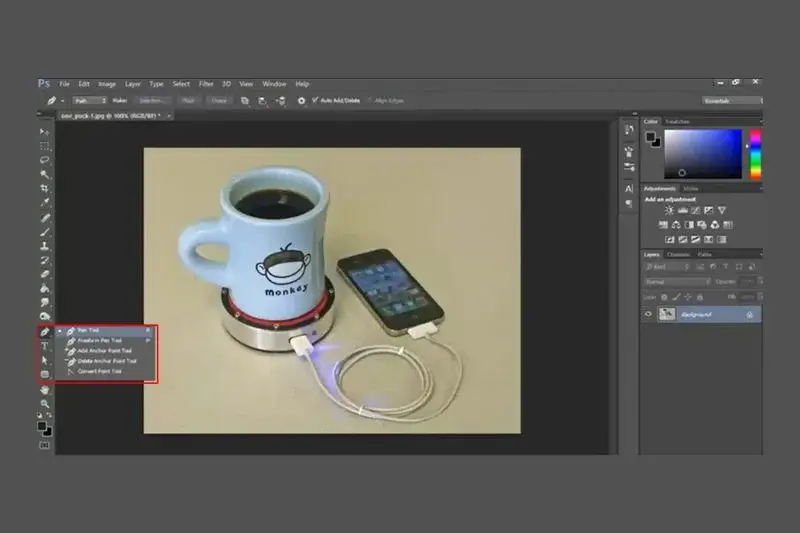
Select the Pen Tool from the toolbar to create a precise vector path around your object.
Step 3: Draw, Complete, and Select the Path

Use the Pen Tool to trace around your object, clicking for points and dragging for curves. Close the path by connecting the last point to the first. Right-click the path, choose “Make Selection”, and set feathering to 0–1 px for sharp edges.
Step 4: Remove or Replace the Background
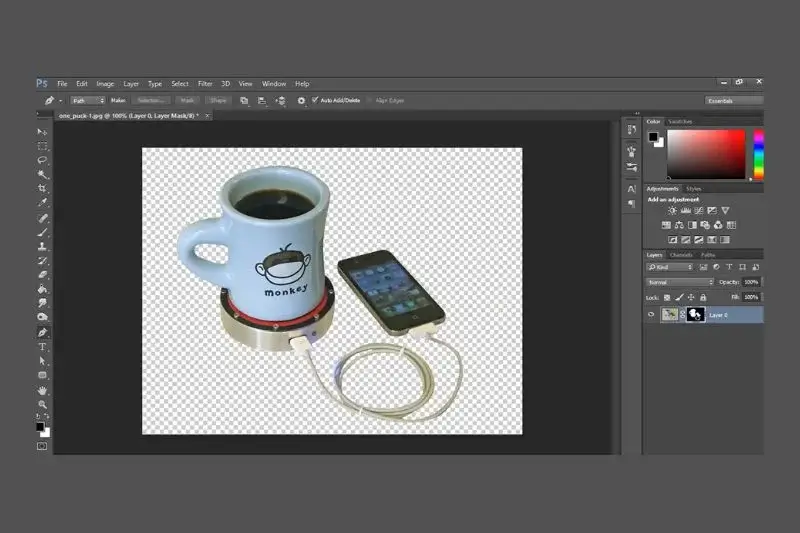
Press Delete to remove the background. Or add a new layer with a different background color. Save in PNG or PSD format to preserve transparency. If you want a clean white background for eCommerce, try our Background Removal Service.
By following this tutorial, you can achieve clean, professional images suitable for eCommerce, marketing campaigns, or portfolios. You can also learn it from online clipping path tutorials on different platforms.
Types of Clipping Path
After understanding how a clipping path works, it’s important to know the different types. The right clipping path technique depends on how simple or complex the object is.
1. Simple Clipping Path

A simple or basic clipping path is a clipping path technique used to cut out objects with simple shapes from their backgrounds. Examples include boxes, bottles, etc. This is a quick process that requires a single path with minimal anchor points.
2. Medium Clipping Path
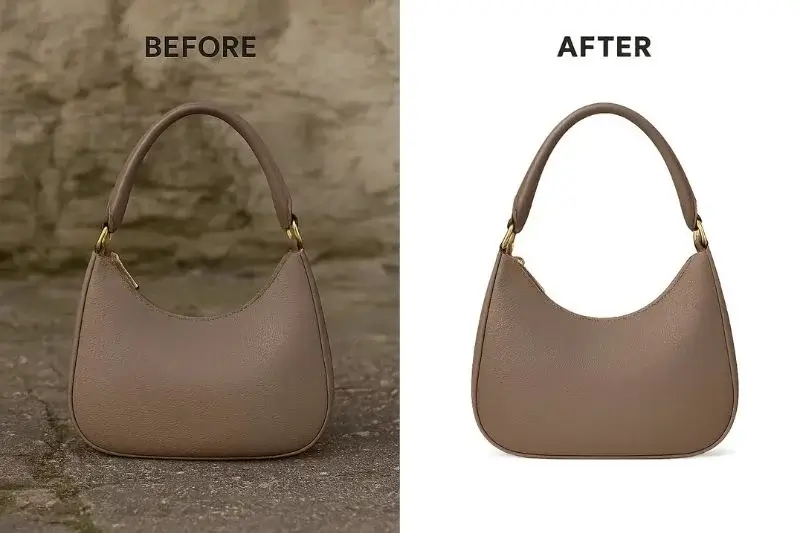
A medium clipping path handles objects with slight curves or minor details, such as shoes, handbags, or small accessories. This technique requires more precision than simple clipping paths. eCommerce product photography often uses medium clipping paths to make products look neat and clean.
3. Complex Clipping Path

A complex clipping path is used for objects with many curves and small details, such as jewelry, plants, or decorative items. This technique uses many anchor points and usually requires careful manual work to keep the edges accurate. Complex clipping paths are perfect for high-quality product photos, catalogs, and marketing images where clean results are important.
4. Super Complex Clipping Path
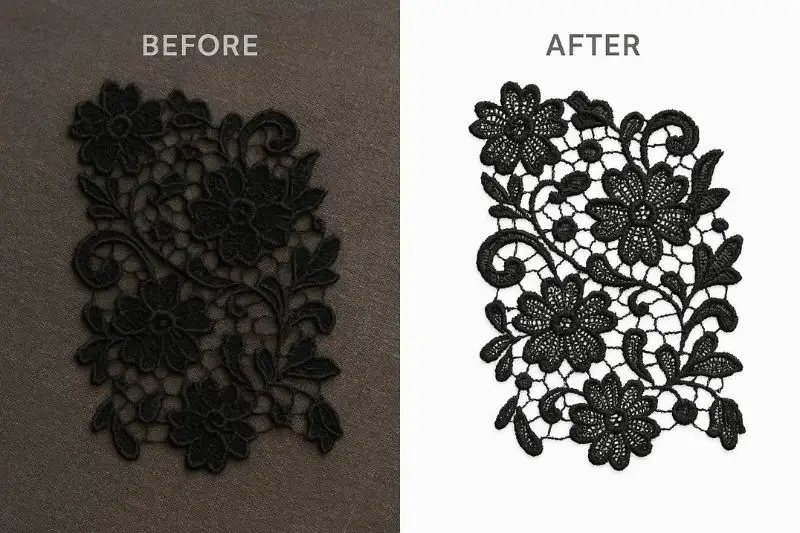
A super complex clipping path, also known as a deep etching, is used for images with multiple tiny parts, fine textures, or highly detailed shapes. Examples include lace, detailed jewelry, or complex group photos.
Understanding these types helps you decide whether to create the clipping path yourself or hire a professional clipping path service for high-quality results.
Clipping Path Cost & Price Per Image
A common question is: How much does a clipping path cost per image? Pricing varies depending on complexity, quantity, delivery time, and add-ons. Below are industry-standard ranges.
Clipping Path Price Breakdown
| Type of Clipping Path | Difficulty | Price Range | Examples |
| Simple / Basic | Easy | $0.20 – $0.50 | Boxes, bottles |
| Medium | Moderate | $0.50 – $1.50 | Shoes, bags |
| Complex | Hard | $1 – $3 | Jewelry, decor |
| Super Complex | Very Hard | $3 – $5+ | Lace, chains |
What Affects Real-World Pricing
- Object Complexity – More curves and holes increase cost.
- Image Quantity – Bulk discounts:
- 50–100 images: 5–10% off
- 100–500 images: 10–20% off
- 1,000+ images: 30–40% off
- Turnaround Time – Rush fees may add 20–100%.
- Additional Services – Shadows, masking, retouching.
- Skill & QA – Premium studios charge more.
For commercial-quality finishing, consider Product Photo Retouching alongside clipping paths.
Quick Formula to Estimate Cost
Total Cost = (Image Quantity × Base Rate) + Add-On Costs + Rush Fees
Example
- 200 medium images @ $0.90
- Shadow add-on @ $0.20
Total = (200 × 0.90) + (200 × 0.20) = 180 + 40 = $220
Industry Pricing Insights
- Global range: $0.20–$5 per image
- U.S./EU agencies often charge $2–$10+
- Masking + clipping usually costs 20–40% more
- Large studios negotiate custom rates
While cheap clipping path services exist, always prioritize quality and accuracy, especially for eCommerce or marketing images. Poorly edited photos can harm your brand and reduce sales.
Why Clipping Path Is Crucial for eCommerce
Now that you know the different types of clipping paths, it’s important to understand why this technique is so valuable—especially in eCommerce.
Since customers cannot touch or test products online, product photos become the main factor that influences buying decisions. This is where the clipping path plays a major role.
Here’s why clipping path is essential for eCommerce:
- Removes distracting backgrounds
- Creates consistent product presentation
- Increases visual clarity and click-through rate
- Meets Amazon/eBay white-background standards
Need clean, marketplace-ready images? Try our professional clipping path service and see the difference in quality.
Who Needs Clipping Path Services?
Clipping path services are widely used by businesses and professionals who need high-quality, polished images. Whether for online stores, portfolios, or marketing campaigns, these services help create clean, professional visuals that stand out.
Key users include:
- eCommerce sellers who want sharp and consistent product images
- Photographers building impressive portfolios
- Marketing agencies need high-quality visuals for campaigns
- Graphic designers and freelancers working on client projects
- Photo editors seeking career opportunities in clipping path jobs
Many objects, especially those with soft edges like hair, fur, or transparent fabrics, may require image masking instead of standard clipping paths.
Common Mistakes in Clipping Path
Even experienced editors can make mistakes when creating clipping paths. Here are the most common errors to watch out for:
- Relying solely on automated tools instead of manual clipping paths
- Creating uneven or rough edges
- Ignoring hair clipping path or soft-edge requirements
- Choosing the cheapest service over quality
Hiring a professional clipping path service ensures precise and clean results every time.
Join over 3,500 eCommerce brands that trust our professional clipping path service for clean, high-quality product images. Experience fast, accurate editing that makes your products look their best. Start your free trial today and see the difference for yourself!
Conclusion
Clipping path isn’t just about cutting out backgrounds—it’s about presenting your product in the most professional and attractive way. High-quality images build trust, increase clicks, and drive sales. Whether your project requires a simple path or an advanced deep-etching workflow, the right editing can completely transform your visuals.
Want perfect, pixel-accurate results? Start your free clipping path trial and experience professional editing firsthand.
Frequently Asked Questions
A clipping path is a hand-drawn vector line used to cut an object from its background for clean, sharp edges.
You trace the object with the Pen Tool, turn the path into a selection, and remove or replace the background.
Use a clipping path for hard edges. Choose image masking for soft, fuzzy, or transparent edges like hair and fur.
Any product with solid edges—such as bottles, shoes, bags, jewelry, or electronics—usually needs a clipping path.
A simple image takes a few minutes. Complex or highly detailed images take longer depending on curves and holes.
About the Author
Clipping World – Clipping Path and Photo Editing Company. With 10+ years of professional experience and 3,500+ global eCommerce clients, Clipping World specializes in clipping paths, masking, and high-end product retouching.

